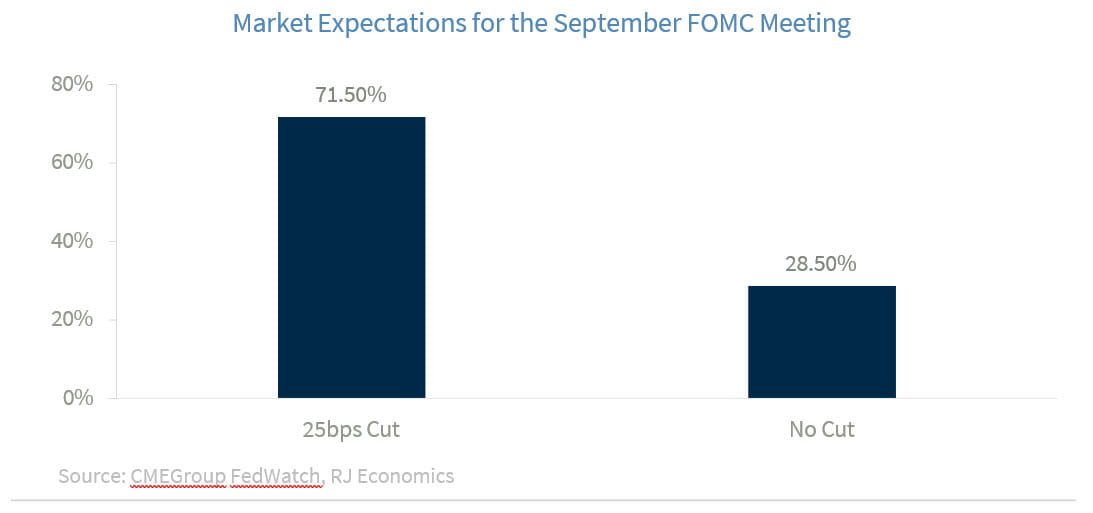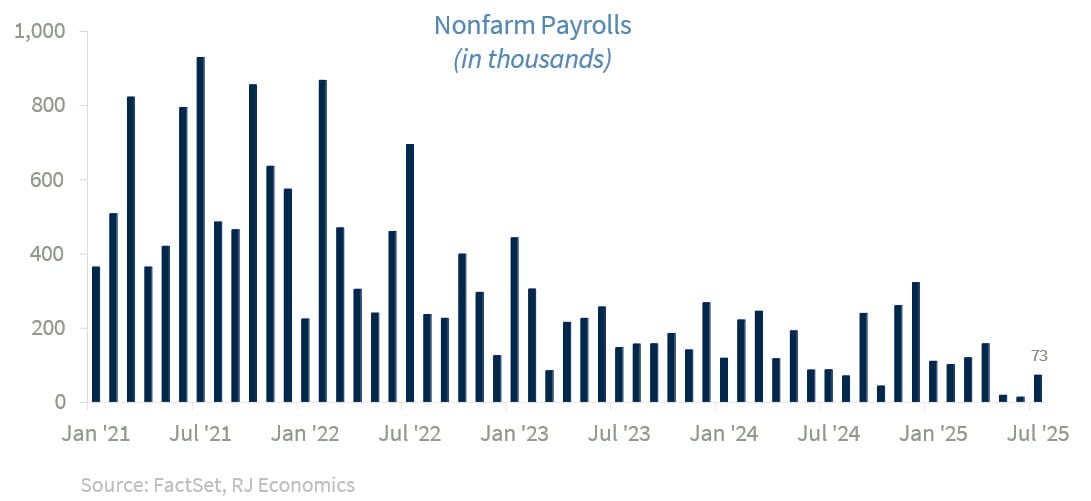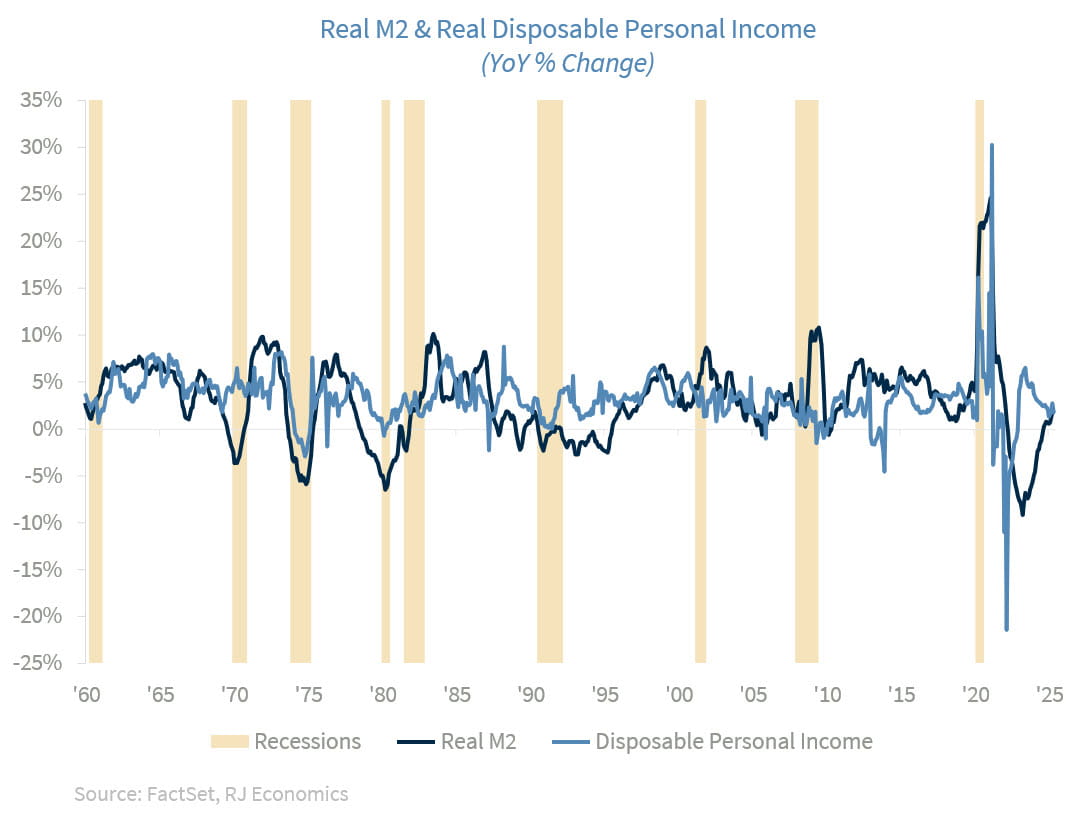Monetary policy: Rules vs. discretion or a happy medium?
Chief Economist Eugenio J. Alemán discusses current economic conditions.
We have been outspoken on the need to cut interest rates sooner rather than later to prevent a recession, as we considered rates too restrictive for the slowing rate of growth of the economy at a time when inflation remained very close to the Federal Reserve’s (Fed) target of 2.0%. We still expect two rate cuts before year end, premised on our economic forecast, which has the economy slowing to a trickle and moving close to recessionary levels, which is why we argued for lower rates during the first half of the year.
But inflation is going to start rearing its ugly head very soon, and, as we said over the last several months, the window to lower rates is closing very quickly, if it hasn’t closed yet. At the same time, the fiscally expansionary effects of the One Big Beautiful Bill Act (OBBBA) are front-loaded, so if the economy is able to avoid a recession, the Fed probably will have to deal with stronger growth in 2026, which could prevent it from lowering interest rates as markets are currently expecting. All this complicates the job of Fed members as they conclude their Jackson Hole meeting and as they approach the September Federal Open Market Committee (FOMC) meeting, two meetings where they will face continued pressure from political actors as well as real pressure from higher inflation readings.
At the same time, we understand the Fed typically follows what markets expect on rates, and today, markets are expecting the Fed to lower rates by 25 basis points during the September FOMC meeting. If the market’s assumption for requiring lower interest rates is that the economy is at risk of falling into a recession, the market’s view would be in line with our view and would require the Fed to lower rates as soon as possible, even if markets have the Fed starting with rate cuts in September versus October for us.
Fed officials’ views since December have been that they are holding off on cutting rates further because the economy continues to grow at a relatively strong pace, while adding, early in the year, that they are waiting to have more certainty on the path of tariffs and their potential effects on inflation. For us, the recent weakness in employment should be a wake-up call for the Fed if it is preparing to cut rates. Additionally, on September 9, the Bureau of Labor Statistics (BLS) will issue its preliminary benchmark revisions to Establishment Survey Data, revising nonfarm payrolls between April 2024 and September 2025. These benchmark revisions could indicate that job growth was even weaker than initially reported, suggesting the economy may be on a more fragile footing than previously believed.
However, the fact that the full effect of tariffs on prices, plus the continuous delay on higher tariffs on Chinese imports, is still not fully accounted for in the data creates more issues for the path of interest rates. It will be interesting to hear Chairman Powell today at Jackson Hole on the new monetary policy framework to see if the institution makes substantive revisions to the previous framework, which was created after the Great Recession disinflationary environment.1 That is, policymakers could make amendments to the policy, potentially changing the way they are going to react to changes in inflation. If they go back to the previous framework, then the discussion on interest rates will probably change substantively.
They could also modify their view on the current economic environment and argue that weakness in employment trumps their current concern about the effects of tariffs on inflation. However, in order to do that, they would have to believe that the deterioration in employment is such that if they don’t move today, they risk sending the US economy into recession.
As we have argued many times in the past, monetary policy is not conducive to a large increase in inflation or if there is higher inflation, the increase will be temporary. This is because real money supply is growing very slowly, as shown in the graph below, while real disposable income has slowed down considerably, making any potential increase in inflation due to tariffs short-lived, which is very different from what happened during the recovery from the COVID-19 pandemic, as shown in the graph on the next page.
1: This framework was adopted in 2012 and revised further in 2024. Here is a link to the Federal Reserve current framework. https://www.federalreserve.gov/monetarypolicy/ files/FOMC_LongerRunGoals.pdf?utm_source=substack&utm_medium=email
Of course, if the Fed reduces interest rates as the Trump administration is proposing or if the administration goes forward with rebating the increase in tax revenues from tariffs back to individuals, this story could change considerably and the potential for inflation that increases and stays higher for longer will increase.
Perhaps the biggest threat we see today has to do with the potential for resetting inflation expectations or what the Fed calls inflationary expectations becoming unanchored. This is what happened during the stagflationary scenarios of the 70s and 80s. However, for that to happen, monetary policy would need to become prey to political pressure, which would mean that the lack of independence in the Fed decision- making process would threaten monetary policy consistency, as occurred during that period.
Although we still don’t see this as a high-risk event, the continued threat to Fed independence is a major risk going forward. If the Fed remains independent from the political process, the Fed will remain cautious when conducting monetary policy. Today, we have a system (with rules like the Taylor rule that wasn’t in place during the 70s and 80s, when changes in monetary policy were more discretionary, with too much political system meddling in monetary policy decisions, which contributed to generating stagflation.2
2: The Taylor Rule is a monetary policy guideline that suggests how central banks should set short-term interest rates in response to changes in inflation and economic output.
Today, they have a mix of rules as well as some discretion to adapt to the current economic environment as well as an inflation targeting mechanism that did not exist back then. Thus, they are much better prepared to avoid a repeat of a stagflation environment. Of course, they have no control over fiscal policy and trade (i.e., tariff policies) so they will have to remain vigilant for the potential effects of those ‘shocks.’
Another risk is a geopolitical shock, like another war that could increase the price of petroleum, as happened during the 70s and 80s. All these events could make a dent in inflation expectations and could make the Fed’s inflation fight even more difficult going forward.
If this was not enough, the current administration’s push to reduce/eliminate the independence of the Federal Reserve, which we wrote about in our Weekly Economics on April 25, 2025 is probably one of the biggest risks to inflation because it will not only make it easier for inflation to increase but it will negatively affect economic agents’ trust in the institution and could make inflationary expectation unanchored. This will have negative consequences for inflation, the US dollar, as well as the standing of the US economy around the globe.
Economic and market conditions are subject to change.
Opinions are those of Investment Strategy and not necessarily those of Raymond James and are subject to change without notice. The information has been obtained from sources considered to be reliable, but we do not guarantee that the foregoing material is accurate or complete. There is no assurance any of the trends mentioned will continue or forecasts will occur. Past performance may not be indicative of future results.
Consumer Price Index is a measure of inflation compiled by the US Bureau of Labor Statistics. Currencies investing is generally considered speculative because of the significant potential for investment loss. Their markets are likely to be volatile and there may be sharp price fluctuations even during periods when prices overall are rising.
Consumer Sentiment is a consumer confidence index published monthly by the University of Michigan. The index is normalized to have a value of 100 in the first quarter of 1966. Each month at least 500 telephone interviews are conducted of a contiguous United States sample.
Personal Consumption Expenditures Price Index (PCE): The PCE is a measure of the prices that people living in the United States, or those buying on their behalf, pay for goods and services. The change in the PCE price index is known for capturing inflation (or deflation) across a wide range of consumer expenses and reflecting changes in consumer behavior.
The Consumer Confidence Index (CCI) is a survey, administered by The Conference Board, that measures how optimistic or pessimistic consumers are regarding their expected financial situation. A value above 100 signals a boost in the consumers’ confidence towards the future economic situation, as a consequence of which they are less prone to save, and more inclined to consume. The opposite applies to values under 100.
Certified Financial Planner Board of Standards Center for Financial Planning, Inc. owns and licenses the certification marks CFP®, CERTIFIED FINANCIAL PLANNER®, and CFP® (with plaque design) in the United States to Certified Financial Planner Board of Standards, Inc., which authorizes individuals who successfully complete the organization’s initial and ongoing certification requirements to use the certification marks.
Links are being provided for information purposes only. Raymond James is not affiliated with and does not endorse, authorize or sponsor any of the listed websites or their respective sponsors. Raymond James is not responsible for the content of any website or the collection or use of information regarding any website's users and/or members.
GDP Price Index: A measure of inflation in the prices of goods and services produced in the United States. The gross domestic product price index includes the prices of U.S. goods and services exported to other countries. The prices that Americans pay for imports aren't part of this index.
Employment cost Index: The Employment Cost Index (ECI) measures the change in the hourly labor cost to employers over time. The ECI uses a fixed “basket” of labor to produce a pure cost change, free from the effects of workers moving between occupations and industries and includes both the cost of wages and salaries and the cost of benefits.
US Dollar Index: The US Dollar Index is an index of the value of the United States dollar relative to a basket of foreign currencies, often referred to as a basket of U.S. trade partners' currencies. The Index goes up when the U.S. dollar gains "strength" when compared to other currencies.
The FHFA HPI is a broad measure of the movement of single-family house prices. The FHFA HPI is a weighted, repeat- sales index, meaning that it measures average price changes in repeat sales or refinancings on the same properties.
Import Price Index: The import price index measure price changes in goods or services purchased from abroad by U.S. residents (imports) and sold to foreign buyers (exports). The indexes are updated once a month by the Bureau of Labor Statistics (BLS) International Price Program (IPP).
ISM Services PMI Index: The Institute of Supply Management (ISM) Non-Manufacturing Purchasing Managers' Index (PMI) (also known as the ISM Services PMI) report on Business, a composite index is calculated as an indicator of the overall economic condition for the non-manufacturing sector.
The ISM Manufacturing Index: The GDP Now Institute of Supply Management (ISM) Manufacturing Measures the health of the manufacturing sector by surveying purchasing managers at manufacturing firms. The survey asks about current business conditions and expectations for the future, including new orders, inventories, employment, and deliveries.
Consumer Price Index (CPI) A consumer price index is a price index, the price of a weighted average market basket of consumer goods and services purchased by households.
Producer Price Index: A producer price index (PPI) is a price index that measures the average changes in prices received by domestic producers for their output.
Industrial production: Industrial production is a measure of output of the industrial sector of the economy. The industrial sector includes manufacturing, mining, and utilities. Although these sectors contribute only a small portion of gross domestic product, they are highly sensitive to interest rates and consumer demand.
The NAHB/Wells Fargo Housing Opportunity Index (HOI) for a given area is defined as the share of homes sold in that area that would have been affordable to a family earning the local median income, based on standard mortgage underwriting criteria.
Conference Board Coincident Economic Index: The Composite Index of Coincident Indicators is an index published by the Conference Board that provides a broad-based measurement of current economic conditions, helping economists, investors, and public policymakers to determine which phase of the business cycle the economy is currently experiencing.
Conference Board Lagging Economic Index: The Composite Index of Lagging Indicators is an index published monthly by the Conference Board, used to confirm and assess the direction of the economy's movements over recent months.
New Export Index: The PMI New export orders index allows us to track international demand for a country's goods and services on a timely, monthly, basis.
Gold is subject to the special risks associated with investing in precious metals, including but not limited to: price may be subject to wide fluctuation; the market is relatively limited; the sources are concentrated in countries that have the potential for instability; and the market is unregulated.
The Conference Board Leading Economic Index: Intended to forecast future economic activity, it is calculated from the values of ten key variables.
Source: FactSet, data as of 7/25/2025




